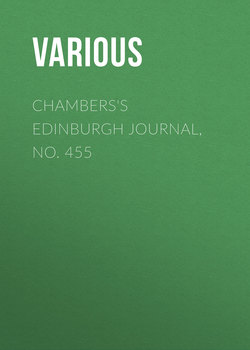Chambers's Edinburgh Journal, No. 455

Реклама. ООО «ЛитРес», ИНН: 7719571260.
Оглавление
Various. Chambers's Edinburgh Journal, No. 455
A GLANCE AT CONTINENTAL RAILWAYS
A NEW PRINCIPLE IN NATURE
ENGLISH SISTERS OF CHARITY
BRIBERY AND CORRUPTION
THE EGYPTIAN MUSEUM, LIVERPOOL
UNCLE TOM'S CABIN
HANDEL IN DUBLIN
ROYAL GARDENING
UNDER THE PALMS
Отрывок из книги
It is pretty well known that researches by Matteucci, Du Bois-Reymond, and others, have made us acquainted with the influence of electricity and galvanism on the muscular system of animals, and that important physiological effects have been attributed to this influence, more than perhaps we are warranted in assuming in the present state of our knowledge. That an influence is exerted in some way, is clear from the difference in our feelings in dry and wet weather: it has been supposed, however, that the effects on the nervous system are not produced by an accumulation of positive or of negative electricity, but by the combination of the two producing dynamic electricity. While these points are undergoing discussion, we have an opportunity of bringing before our readers the results of investigations bearing on the general question.
Most persons are aware of the fact, that a peculiar taste follows the application of two different metals to the tongue in a popular galvanic experiment. This taste is caused by the azotic acid formed from the oxygen and azote of the atmosphere. An electric discharge, too, is accompanied by a smell, which smell is due to the presence of what is called ozone; and not long ago M. Schoenbein, of Basel, the inventor of guncotton, discovered ozone as a principle in the oxygen of the atmosphere; and it is considered to be the active principle of that universal constituent. Later researches have brought out a striking analogy between the properties of ozone and chlorine, and have led to conclusions as to the dangerous effect which the former may produce, in certain cases, on the organs of respiration. Some idea of its energy may be formed from the fact, that mice perish speedily in air which contains one six-thousandth of ozone. It is always present in the atmosphere in a greater or lesser degree, in direct relation with the amount of atmospheric electricity, and appears to obey the same laws in its variations, finding its maximum in winter and its minimum in summer.
.....
Whichever way the ozone be produced, it is always identical in its properties; and these are described as numerous and remarkable. Its odour is peculiar, resembling that of chlorine, and, when diluted, cannot be distinguished from what is called the electric smell. When largely diffused in atmospheric air, it causes unpleasant sensations, makes respiration difficult, and, by acting powerfully on the mucous membranes, produces catarrhal effects; and as such air will kill small animals, it shews that pure ozone must be highly injurious to the animal economy. It is insoluble in water, is powerfully electromotive, and is most strikingly energetic in numerous chemical agencies, its action on nearly all metallic bodies being to carry them at once to the state of peroxide, or to their highest point of oxidation; it changes sulphurets into sulphates, instantaneously destroys several gaseous compounds, and bleaches indigo, thus shewing its analogy with chlorine.
In proceeding to the account of his experiments, M. Schoenbein shews, that gases can be produced by chemical means, which exercise an oxidizing influence of a powerful nature, especially in their physiological effects, even when diffused through the atmosphere in very minute quantities: also, that owing to the immense number of organic beings on the earth, their daily death and decomposition, an enormous amount of gases is produced similar to those which can be obtained by artificial means; and besides these, a quantity of gaseous or volatile products, 'whose chemical nature,' as the author observes, 'is as yet unknown, but of which we can easily admit that some, at least, diffused through the air, even in very small quantities, and breathed with it, exert a most deplorable action on the animal organism. Hence it follows, that the decomposition of organic matters ought to be considered as one of the principal causes of the corruption of the air by miasmatic substances. Now, a continuous cause, and acting on so vast a scale, would necessarily diffuse through the atmosphere a considerable mass of miasmatic gases, and accumulate them till at length it would be completely poisoned, and rendered incapable of supporting animal life, if nature had not found the means of destroying these noxious matters in proportion as they are produced.'
.....